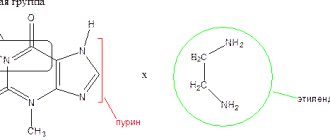Ipigrix solution for injection 15mg/ml 1ml ampoules No. 10
INSTRUCTIONS FOR MEDICAL ADMINISTRATION
1. NAME OF THE MEDICINE
IPIGRIX
2. GENERAL CHARACTERISTICS
International nonproprietary name: ipidacrin (ipidacrinum) Description Transparent, colorless liquid.
3. COMPOSITION OF THE MEDICINE
1 ml of solution contains: active substance: shdacrine hydrochloride (in terms of anhydrous substance) 5 mg < ) or 15 mg, excipients: 1 M hydrochloric acid solution to pH 2.8-4.0, water for injection up to 1 ml.
4. FORM OF RELEASE
Injection.
5. MEDICINE CLASSIFICATION CODE
Anticholinesterase drugs. ATX code: N07AA.
6. PHARMACOLOGICAL PROPERTIES Pharmacodynamics
A reversible cholinesterase inhibitor, prevents the enzymatic hydrolysis of acetylcholine and prolongs its action. Blocks membrane potassium channels and promotes their depolarization. Stimulates synaptic transmission in neuromuscular endings, conduction of excitation in nerve fibers, enhances the effect of acetylcholine and other mediators (epinephrine, serotonin, histamine, oxytocin) on smooth muscles, restores neuromuscular transmission and conduction of excitation in the peripheral nervous system (due to disorders of various origins: trauma, inflammation, the action of local anesthetics, antibiotics and toxins). Increases the tone and contractility of the smooth muscles of internal organs, including the gastrointestinal tract (GIT) and bronchi (up to bronchospasm), reduces the heart rate (HR), increases the secretion of the salivary glands, the contractile activity of the myometrium, and the tone of the skeletal muscles. It has a stimulating effect on the central nervous system (CNS) in combination with individual manifestations of sedation; helps improve learning and memory. Pharmacokinetics Absorption Ipidacrine is rapidly absorbed after parenteral administration. Potent concentration in plasma after subcutaneous or intramuscular administration for 25-30 minutes. About 40-55% of the active substance is bound to plasma. The therapeutic effect is manifested through parenteral administration. The duration of action of the drug is 3-5 hours. Distribution The drug penetrates the blood-brain barrier. Ipidacrine quickly enters the tissues, and at equilibrium only 2% of the drug is found in the plasma. Metabolism and excretion The drug is metabolized in the liver. Ipidacrine is excreted renal and extrarenally (by biotransformation in the liver), excretion in the urine predominates. The half-life of ipidacrine elimination is 0.7 hours. After parenteral administration of ipidacrine unchanged, 34.8% of the administered dose is excreted in the urine. This indicates rapid metabolism of the drug in the body.
7. INDICATIONS FOR USE
— Diseases of the peripheral nervous system (neuritis, polyneuritis, polyneuropathy, polyradiculoneuropathy); — myasthenia gravis and other myasthenic syndromes; — bulbar paralysis and paresis with organic lesions of the central nervous system, accompanied by motor disorders (recovery period); — demyelinating diseases of the central nervous system (as part of complex therapy); — memory disorders of various origins (Alzheimer’s disease and other forms of senile dementia); - intestinal atony.
8. METHOD OF APPLICATION AND DOSAGE
Doses and duration of treatment are determined individually depending on the severity of the disease. Ipidacrine solutions containing 5 mg/ml and 15 mg/ml are administered intramuscularly and subcutaneously. Diseases of the peripheral nervous system, demyelinating diseases of the central nervous system (as part of complex therapy): 5-15 mg of ipidacrine subcutaneously (1 ml of a solution containing 5 mg or 15 mg of ipidacrine in 1 ml) 1-2 times a day. The duration of treatment is 1-2 months. If necessary, the course of treatment can be repeated several times with an interval of 1-2 months. For acute mononeuritis, use 5 mg of ipidacrine (1 ml of solution containing 5 mg of ipidacrine in 1 ml) 1-2 times a day in combination with anti-inflammatory and decongestant drugs. The duration of the course of treatment is 10-15 days. For chronic neuritis and polyradiculoneuritis, if previous therapy did not provide a sufficient therapeutic effect, use 10 mg of ipidacrine (2 ml of a solution containing 5 mg of ipidacrine in 1 ml) 1-2 times a day. The duration of treatment is 20-30 days. If necessary, the course of treatment can be repeated 2-3 times with an interval of 2-4 weeks. For myelopolyradiculoneuritis with paresis of all extremities, use 15-20 mg of ipidacrine (1 ml of a solution containing 15 mg of ipidacrine in 1 ml or 4 ml of a solution containing 5 mg of ipidacrine in 1 ml) 2-3 times a day. The duration of treatment is 30-40 days.
The duration of treatment is 1-2 months. If necessary, the course of treatment can be repeated several times with an interval of 1-2 months. To prevent the development of myasthenic crisis in case of severe impairment of neuromuscular conduction, 15-30 mg of ipidacrine (1-2 ml of a solution containing 15 mg of ipidacrine in 1 ml) is administered for a short time. Boulevard paralysis and paresis due to organic lesions of the central nervous system, accompanied by motor disorders (recovery period): for head injuries in the acute period (3-5 days after injury), 1-2 ml of a solution containing 5 mg of ipidacrine in 1 ml is prescribed, 1-2 once a day. On days 5-6 after injury, the dose can be increased to 30-45 mg of ipidacrine (2-3 ml of a solution containing 15 mg of ipidacrine in 1 ml), 1-3 times a day. In some cases, in case of severe disorders of brain activity, ipidacrine is administered intravenously infusion along with 5% or 0.9% sodium chloride solution. The course of treatment is prescribed individually, usually lasting 30-40 days. Memory disorders of various origins (Alzheimer's disease and other forms of senile dementia): doses and duration of treatment are prescribed individually. The recommended dose at the beginning of treatment is 10 mg of ipidacrine (2 ml of solution containing 5 mg of ipidacrine in 1 ml) 2 times a day. Then the dose is gradually increased. The maximum dose can sometimes reach 120-200 mg per day and the duration of treatment is from 4 months to 1 year. Intestinal atony: use 10-20 mg of ipidacrine (2-4 ml of solution containing 5 mg of ipidacrine in 1 ml) 2-3 times a day. The duration of treatment is 1-3 weeks. 9. SIDE EFFECTS Ipidacrine is usually well tolerated. Side effects are mainly associated with stimulation of M-cholinergic receptors.
The following side effects are classified according to MedDRA organ system groups. To divide the frequency of occurrence, the following classification was used: often (>1/100 to <1/10), less often (>1/1000 to <1/100), rarely (>1/10,000 to <1/1000). Gastrointestinal disorders Common: hypersalivation, nausea. Less common: vomiting. Rarely: diarrhea, epigastric pain. Unknown: dyspepsia. Nervous system disorders
Less common: dizziness, headaches, drowsiness, muscle spasms, weakness. Cardiac dysfunction Often: palpitations, bradycardia. Eye damage Unknown: miosis.
Damage to the respiratory system, diseases of the chest and mediastinum Less common: increased bronchial secretion. Damage to the musculoskeletal and related systems Unknown: tremor. Damage to the skin and adjacent tissues Often: increased sweating. Less common: allergic reactions (itching, rashes), usually when used in large doses. General disorders and administration site reactions Not known: hypothermia, chest pain. Salivation and bradycardia can be reduced with the help of anticholinergic drugs (atropine and others). If side effects occur, you should reduce the dose or stop using the drug for a short time (for 1-2 days).
10. CONTRAINDICATIONS
Epilepsy, extrapyramidal disorders with hyperkinesis, angina pectoris, bradycardia, bronchial asthma, a tendency to vestibular disorders, peptic ulcer of the stomach and duodenum in the acute phase, intestinal or urinary tract obstruction, pregnancy, lactation, hypersensitivity to the components of the drug. The use of ipidacrine in children is contraindicated due to the lack of clinical studies on safety in this age group.
11. OVERDOSE
Symptoms: in case of severe overdose, a cholinergic crisis may develop (bronchospasm, lacrimation, increased sweating, constriction of the pupils, nystagmus, increased gastrointestinal motility, spontaneous defecation and urination, vomiting, jaundice, bradycardia, intracardiac conduction disturbances, arrhythmias, arterial hypotension, restlessness, anxiety, excitement, fear, ataxia, convulsions, coma, speech impairment, drowsiness, general weakness). Treatment: symptomatic therapy is carried out, m-anticholinergics are used (including atropine, cyclodol, metacin).
12. PRECAUTIONS
Use with caution in patients with gastric and duodenal ulcers, thyrotoxicosis, diseases of the cardiovascular system, acute respiratory tract diseases, as well as in patients with a history of respiratory system diseases. Pregnancy and breastfeeding. Ipidacrine increases uterine tone and can cause premature labor, so it should not be used during pregnancy. This drug should not be used while breastfeeding. fI
Impact on the ability to drive vehicles and maintain machinery. Ipidacrine may have a sedative effect, so caution should be exercised in those exposed to this effect.
13. INTERACTION WITH OTHER DRUGS Ipidacrine weakens the inhibitory effect on neuromuscular transmission and the conduction of excitation along peripheral nerves of local anesthetics, aminoglycosides and potassium chloride. The sedative effect of drugs that depress the central nervous system, including ethanol, as well as the effect of other cholinesterase inhibitors and m-cholinergic stimulants are enhanced by ipidacrine. Compared to other cholinergic drugs, ipidacrine increases the risk of cholinergic crisis in patients with myasthenia gravis. Beta-blockers increase the severity of bradycardia caused by ipidacrine. Cerebrolysin improves the mental activity of ipidacrine.
14. CONDITIONS AND STORAGE DURATION
Store at a temperature no higher than 25 C. Do not freeze! Keep out of the reach of children. Shelf life - 2 years. Do not use after the expiration date stated on the package.
15. HOLIDAY CONDITIONS
On prescription.
16. PACKAGING
1 ml in a colorless glass ampoule with two marking rings of yellow and red (solution for injection 5 mg/ml) or green and red (solution for injection 15 mg/ml) and with a line or break point. 5 ampoules in a cell package. 2 cell packs with instructions for use in a cardboard pack.
17. INFORMATION ABOUT THE MANUFACTURER (APPLICANT) Registration Certificate Holder
JSC Grindeks. St. Krustpils, 53, Riga, LV-1057, Latvia Phone: +371 67083 205 Fax: +371 67083 505 E-mail Manufacturer HBM Pharma s.r.o. St. Sklabinska 30, Martin 036 80, Slovakia
Ipigrix tablets 20 mg No. 25x2
Name
Ipigrix tablet 20 mg in blister pack. in pack No. 25x2
Description
Round flat-cylindrical tablets of white or almost white color with a chamfer.
Main active ingredient
Ipidacrine hydrochloride
Release form
25 tablets in a blister made of aluminum foil and polyvinyl chloride film. 2 blisters along with instructions for medical use in a cardboard pack.
Dosage
20 mg per blister. in pack No. 25x2
Pharmacodynamics
A reversible cholinesterase inhibitor, prevents the enzymatic hydrolysis of acetylcholine and prolongs its action. Blocks membrane potassium channels and promotes their depolarization. Stimulates synaptic transmission in neuromuscular endings, conduction of excitation in nerve fibers, enhances the effect of acetylcholine and other mediators (epinephrine, serotonin, histamine, oxytocin) on smooth muscles, restores neuromuscular transmission and conduction of excitation in the peripheral nervous system (due to disorders of various origins: injuries, inflammation, effects of local anesthetics, antibiotics, toxins, potassium chloride). Increases the tone and contractility of the smooth muscles of internal organs, including the gastrointestinal tract (GIT) and bronchi (up to bronchospasm), reduces the heart rate (HR), increases the secretion of the salivary glands, the contractile activity of the myometrium, and the tone of the skeletal muscles. It has a stimulating effect on the central nervous system (CNS) in combination with individual manifestations of sedation; helps improve memory.
Pharmacokinetics
Ipidacrine is rapidly absorbed after parenteral (solution for injection) and oral administration (tablets). Maximum concentrations of the drug in the blood are observed one hour after oral administration, the half-life of distribution is 0.7 hours. Ipidacrine penetrates the blood-brain barrier. Approximately 40-55% binds to blood proteins. Absorbed predominantly from the duodenum and to a lesser extent from the stomach and small intestine. From the blood, ipidacrine quickly enters the tissues, and at equilibrium, only 2% of the drug is found in the serum. Ipidacrine is metabolized in the liver, excreted mainly through renal mechanisms and partly through biotransformation in the liver and elimination in the bile. The half-life of elimination is 40 minutes. After oral administration, only 3.7% of ipidacrine is excreted unchanged. This indicates the rapid metabolism of ipidacrine in the body. After parenteral administration, 34.8% of ipidacrine is excreted unchanged in the urine.
Indications for use
Diseases of the peripheral nervous system (neuritis, polyneuritis, polyneuropathy, polyradiculoneuropathy). Myasthenia and myasthenic syndrome of various etiologies. Memory impairments of various origins and other forms of senile dementia. Treatment and prevention of intestinal atony.
Directions for use and doses
The method of administration, dose and duration of treatment with Ipigrix is determined by the attending physician individually, depending on the severity of the disease. Ipigrix tablets are taken orally. Diseases of the peripheral nervous system, myasthenia gravis and myasthenic syndrome: 10-20 mg 1-3 times a day. Ipigrix 20 mg tablet is not divided into parts; if it is necessary to prescribe a dose of 10 mg, it is recommended to use an injection solution of 5 mg/ml. The course of treatment is from one to two months. If necessary, the course of treatment can be repeated several times with a break between courses of 1-2 months. To prevent myasthenic crises in severe disorders of neuromuscular conduction, 1-2 ml (15-30 mg) of Ipigrix 15 mg/ml solution for injection are administered parenterally for a short time, then treatment is continued with Ipigrix tablets, the dose can be increased to 20-40 mg (1 -2 tablets) 5-6 times a day. Memory impairments of various origins (Alzheimer's disease and other forms of senile dementia): the dose and duration of treatment are determined individually, the maximum daily dose can sometimes reach 200 mg, the course of treatment is from 1 month to one year. Treatment and prevention of intestinal atony: 20 mg (one tablet) 2-3 times a day for 1-2 weeks.
Use during pregnancy and lactation
Ipigrix increases the tone of the uterus and can cause premature birth, so the use of the drug is contraindicated during pregnancy. During breastfeeding, the use of the drug is contraindicated.
Precautionary measures
Use with caution in patients with gastric and duodenal ulcers, thyrotoxicosis, diseases of the cardiovascular system, acute respiratory tract diseases, as well as in patients with a history of respiratory system diseases. Ipidacrine can aggravate the course of epilepsy, as well as increase the negative effects of alcohol on the body.
Interaction with other drugs
Ipidacrine weakens the inhibitory effect on neuromuscular transmission and the conduction of excitation along peripheral nerves by local anesthetics, aminoglycosides and potassium chloride. The sedative effect of drugs that depress the central nervous system, including alcohol, as well as the effect of other cholinesterase inhibitors and m-cholinergic stimulants are enhanced by ipidacrine. Compared to other cholinergic drugs, ipidacrine increases the risk of cholinergic crisis in patients with myasthenia gravis. Beta-blockers increase the severity of bradycardia caused by ipidacrine. Cerebrolysin improves the mental activity of ipidacrine.
Contraindications
Epilepsy, extrapyramidal disorders with hyperkinesis, angina pectoris, bradycardia, bronchial asthma, a tendency to vestibular disorders, peptic ulcer of the stomach and duodenum in the acute phase, intestinal or urinary tract obstruction, pregnancy, lactation, hypersensitivity to the components of the drug. Ipigrix tablets contain lactose and should not be used in cases of rare congenital fructose intolerance, glucose-galactose malabsorption or sucrose-isomaltase deficiency. Children and adolescents Use is contraindicated due to the lack of clinical studies on safety in this age group.
Compound
1 tablet contains: active substance: ipidacrine hydrochloride (in terms of anhydrous substance) 20.0 mg, excipients: lactose monohydrate; potato starch; potato starch, dried; calcium stearate.
Overdose
In case of severe overdose, a “cholinergic crisis” may develop. Symptoms: bronchospasms, lacrimation of the eyes, increased sweating, constriction of the pupils, nystagmus, spontaneous defecation and urination, vomiting, bradycardia, heart block, arrhythmias, hypotension, restlessness, anxiety, agitation, fear, ataxia, convulsions, coma, slurred speech, drowsiness and weakness. Symptoms may be mild. Treatment: symptomatic therapy is used, m-anticholinergics are used (atropine, cyclodol, metacin, etc.).
Side effect
Classification of undesirable side reactions by frequency of development: very often (? 1/10); often (? 1/100 to
Storage conditions
Store at a temperature not exceeding 25 °C. Keep out of the reach of children. Shelf life - 5 years. Do not use after the expiration date stated on the package.


